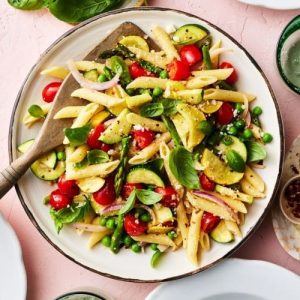
Healthy Pasta Primavera
A quick, colorful pasta loaded with fresh spring vegetables, fragrant herbs, and a touch of pecorino cheese. Perfectly al dente penne is tossed with lemon juice, olive oil, and a pinch of spice for a healthy, satisfying meal.
Equipment
- 1-Large pot
- 1 large deep skillet
- 1 cutting board
- 1 chef’s knife
- 1 wooden spoon or spatula
- 1-Colander
Ingredients
- 10 ounces penne pasta
- 2 tablespoons extra-virgin olive oil plus extra for drizzling
- 4 garlic cloves thinly sliced
- 1 yellow squash sliced into thin half-moons
- 1 zucchini sliced into thin half-moons
- 1 bunch asparagus cut into 1-inch pieces
- 1 cup cherry tomatoes halved
- 1 cup red onion thinly sliced
- 1 teaspoon sea salt
- ½ cup frozen peas thawed
- ¾ cup grated pecorino cheese
- 3 tablespoons fresh lemon juice
- ¼ teaspoon red pepper flakes adjust to taste
- 1 cup fresh basil leaves plus extra for garnish
- ¼ cup fresh tarragon optional
- Freshly ground black pepper to taste
Instructions
- Prepare the Pasta: Bring a large pot of water to a rolling boil, adding a generous pinch of sea salt to enhance flavor. Once boiling, carefully add the penne pasta and cook according to the package instructions until al dente, ensuring it remains firm yet tender. Stir occasionally to prevent sticking. Once cooked, drain the pasta in a colander, then return it to the pot or a large bowl. Drizzle lightly with a bit of extra-virgin olive oil and toss gently to prevent the noodles from clumping while you prepare the vegetables.
- Heat the Olive Oil: Place a large, deep skillet or sauté pan over medium heat and pour in 2 tablespoons of extra-virgin olive oil. Allow the oil to warm for about 30–60 seconds until it shimmers slightly. This step ensures the garlic and vegetables will cook evenly without burning. Keep the heat moderate to maintain a gentle sauté rather than a deep fry.
- Sauté the Garlic: Add the thinly sliced garlic cloves to the warm oil and stir immediately. Allow the garlic to release its fragrant aroma for 30–45 seconds, being careful not to let it brown, as burnt garlic can taste bitter. Stir continuously so that the garlic infuses the oil evenly, creating a flavorful base for the vegetables.
- Cook the Vegetables: Add the sliced yellow squash, zucchini, chopped asparagus, halved cherry tomatoes, and thinly sliced red onion to the skillet. Sprinkle in the teaspoon of sea salt and a few grinds of freshly ground black pepper. Using a wooden spoon or spatula, gently toss the vegetables to coat them in the garlic-infused olive oil. Sauté for approximately 3–4 minutes, stirring occasionally, until the vegetables are tender but still crisp. You want them to retain their vibrant color and a slight bite, which ensures maximum flavor and texture.
- Incorporate the Pasta and Peas: Once the vegetables are tender, add the cooked pasta directly into the skillet. Pour in the thawed peas, ¾ cup of grated pecorino cheese, and 3 tablespoons of fresh lemon juice. Sprinkle in a pinch of red pepper flakes for a subtle kick. Gently toss everything together so that the pasta is evenly coated with the cheese, lemon, and vegetable mixture. This combination allows the heat from the pasta to slightly melt the cheese, creating a light, creamy texture that clings to each noodle.
- Add Fresh Herbs: Tear the fresh basil leaves and stir them into the pasta and vegetable mixture. If you’re using tarragon, add it at this stage as well. The herbs add bright, aromatic flavors that enhance the freshness of the dish. Taste and adjust seasoning with extra salt, black pepper, or red pepper flakes as needed to suit your preference.
- Plate and Garnish: Transfer the pasta primavera to serving plates or a large serving bowl. Drizzle a small amount of extra-virgin olive oil over the top for shine and added richness. Garnish with additional torn basil leaves for a vibrant, fresh presentation. For extra indulgence, sprinkle a little more pecorino cheese if desired. Serve immediately while warm for the best flavor and texture.
Notes
- Use seasonal vegetables for the freshest flavor and maximum nutrition; swap asparagus for green beans or bell peppers if desired.
- Be careful not to overcook the pasta or vegetables; they should be tender yet retain a slight bite for the best texture.
- Fresh herbs elevate the dish, but dried basil or tarragon can be substituted in a pinch, though the flavor will be less vibrant.
- Adjust red pepper flakes according to your heat preference; a small pinch adds warmth without overpowering the vegetables.
- Pecorino cheese adds a salty, nutty note; parmesan can be used as a milder alternative.